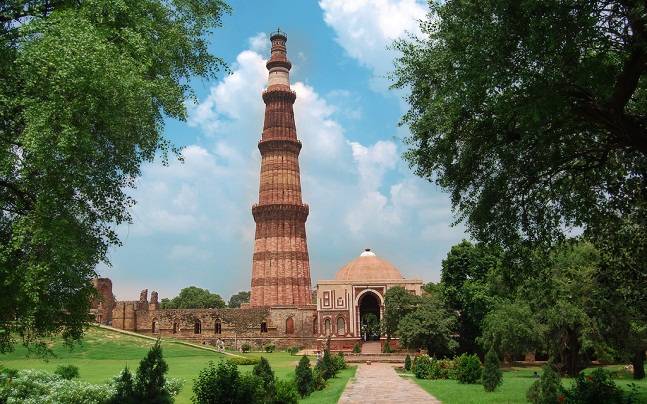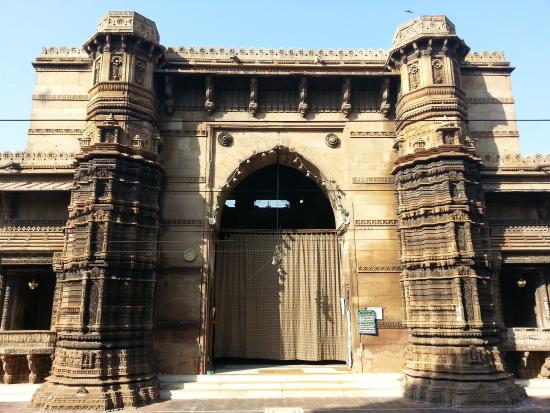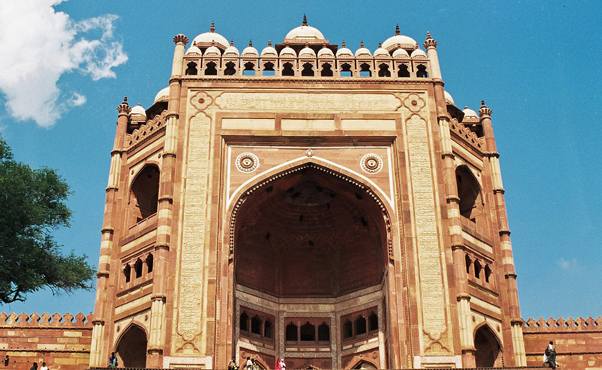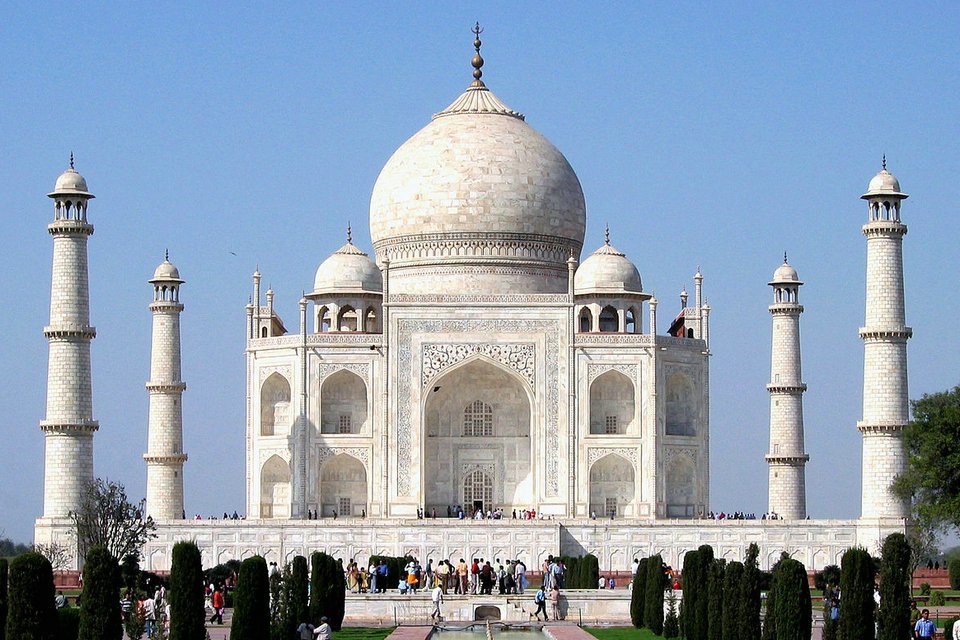- Home
- Culture of India
- Indian Architecture
- Indo-Islamic Architecture
Indo-Islamic Architecture
Indo-Islamic Architecture:
Indo-Islamic style of architecture developed during the medieval period. It was neither strictly Islamic nor Hindu. Islam came to India around 7th and 8th century. Muslims came to India as traders, holy men and as conquerors.
With them they also
got the Islamic architecture and the art. With this many new features and techniques
were introduced into the construction of buildings. By 12th century
India became familiar with the monumental construction and also with some
popular features like the brackets, pillars and a shallow dome.
The Indo-Islamic was neither completely Muslim nor completely Hindu but it was a combination of both elements. It is very important to understand that the Muslims absorbed and understood the local culture and the traditions.
They also
combined it with their architectural practice. It can be divided into two main
categories namely architecture of Delhi Sultanate and Mughal architecture.
Most of the
Hindu monument had carvings of God and Goddess but Muslims did not replicate
any living forms on the surface. Muslims built large buildings like the mosque
and tombs with a large dome and arches which was completely new to Hindu
architecture. Most of the Hindu temples had large Gopuram at the entrance of
the temple.
Styles of Indo-Islamic Architecture
Based on the
different style Indo-Islamic architecture is categorised into different styles
namely the Imperial style of Delhi Sultanate, the Provincial style of Gujarat, Jaunpur
and Bengal, the Mughal Style of Delhi and Agra and the Deccan style of Bijapur
and Golconda. With the fall of Mughal Empire the regional kings in Mysore,
Lucknow and Hyderabad continued to commission various buildings in Mughal style
architecture.
Some of the features of both the forms of architecture in respect of mosque and temple was that both styles had ornamental decoration but both had many difference s well. In mosque the prayer Hall was very wide and spacious were as in temple it is comparatively small and less spacious.
The temple has grabha griha and small
halls in front of the grabha griha where one can see the God. The grabha griha
is usually very small with no light. Where as in mosque the prayer hall is very
wide and the Mihrab is facing towards Mecca. Mihrab is a semi circular niche in
the wall that indicates the quibla (the direction towards Mecca).
Architecture under Delhi Sultanate

Delhi
Sultanate an Islamic empire ruled most parts of North India for over 320 years
from 1206-1526. Five successive dynasties that comprised the Delhi Sultanate
are Mamulk dynasty, Khiliji dynasty, Tughlaq dynasty, Sayyid Dynasty and Lodi
Dynasty. During the period of Delhi Sultanate many beautiful architectural
monuments were built which are world famous even to this day.
During their rule many Hindu and Jain temples were vandalised and damaged and new Indo Islamic architecture were commissioned in that place. Quwwat-ul-Islam mosque was the first mosque built in Delhi. It was commissioned by Qutb-ud-din Aibak of Slave dynasty.
It was built by demolishing 27 Hindu and Jain temples within
the centre of citadel. The inscription on the eastern gate is the proof of
presence of temples in that place. The construction was started in the year
1193 and was completed in the year 1197.
The construction
of Qutb complex was started in the year 1199 under Muhammad of Ghor. The construction
in Qutb complex continued till Qutb ud Din Aibak and later rulers. Some of the
important buildings in Qutb complex include Qutb Minar, Quwwat-ul-Islam and
Alai Darwaza.
Qutub Minar is 73 m tall tower with five stories was constructed in the red stone. It has 379 spiral steps and is one of the famous tourist’s attractions in Delhi India. Qutb-ud-Din Aibak started the construction of Qutub Minar however it was completed by his successor and son in law Iltutmish.
The surface of the Qutub Minar is broad and is filled with
beautiful inscriptions all around. Alai Darwaza further adds to the beauty of
Qutb Complex. Later Tomb of Iltutmish was added in the complex. Alai Darwaza
was constructed by Ala-ud-Din- Khiliji of Khiliji Dynasty in the year 1311 AD.
Another important mosque that was constructed by demolishing Hindu temples include Adhai-din-ka-Jhonpra in Ajmer Rajasthan India. It was constructed by Qutb-ud-Din which has carved pillars all around.
However the mosque retained some of the
original features like the pillars from the Hindu and Jain temples. It was
originally a Sanskrit college which had the idol of Goddess Saraswati in it.
The world
class monuments constructed during Tughlaq period in Delhi include Tughlakabad which
is solid walls. It was a fortified city which was built by Ghiyath ud Din
Tughlaq and also Firozabad fort and palace constructed by Firoz Shah Tughlaq
are some of the architectural features of Tughlaq dynasty.
Pre Mughal Architecture
After the fall
of Tughlaq dynasty regional dynasties gained more power and started their own
architectural constructions. The architecture of Deccan, Gujarat, Bengal and
Kashmir were more improved and different from the Delhi sultanate architecture.
The important material used by the Bengal Sultanate was brick like the pre Islamic architecture. Bengal was in abundance of brick as compared to stone.
Hence
stone was used only to high light prominent details which were reused from
Hindu or Buddhists temple. Some of the prominent stone walls can be found in
Chota Sona Mosque and in Baro Sona Mosque. To ornament this mosque terracotta
panels carved in relief were used.
The most important ornamentation was seen at
the entrance of the mosque. The ornamentation of the mosque consists of small
mosaic disc in different colors of blue and white. There are also two tombs
with verses of Quran on it. But it is not known whose tombs are these. Glazed
tiles are also used in the mosque.

Muzaffarid
dynasty which ruled Gujarat from 1391 to 1583 has commissioned many
architectural monuments particularly in Ahmadabad Gujarat India. Some of the
architectural monuments during this period include Jami Masjid in Ahmadabad,
Qutbuddin Mosque, Rani Rupamati Mosque, Sarkhej Roza, Sidi Bashir Mosque, Sidi
Sayyed Mosque Bhadra Fort are some of the important monuments.
They developed their own style of architecture which was known as Gujarat style. It was a blend of Islamic architecture with the traditional Indian architecture. The minarets were different as compared to Islamic style.
It was usually at the
entrance which had lot of carvings and was very thin as compared to Islamic
minarets. During the period of Beghara step well were built at Dada Harir in
the year 1499. The monuments built during Gujarat period had beautiful and
unique carvings all around.
The Deccan sultanate period was one of the most interesting periods in the Southern part of India.
The mosque built by the Bahamani Sultanate in Gulbarga Fort has no
courtyard. The Gol Gumbad in Bijapur has the largest dome in the world covering
a surface of over 1600 sq metres. It was built by Muhammed Adil Shah. With the
arrival of Mughals the beautiful Mughal architecture was started.
Mughal Architecture

Babur founded and established the Mughal
Empire in India in the year 1526. Some of the breath taking monuments that are
world famous even to this day were built during Mughal period. Mughal
architecture is another type of Indo-Islamic architecture that developed during
Mughal period in India from 16th century. Some of the historical
monuments that were built are Taj Mahal, Humayun’s tomb, Jama Masjid, Red Fort,
Agra Fort, Fathepur Sikri and many more.
Mughal architecture was the blend of Indian with Persian and Islamic elements. They mostly used white marble and red sandstone with huge and beautiful garden all around the monument. Akbar made major contributions to Mughal architecture along with Shah Jahan who built Taj Mahal for his beloved wife Mumtaz Mahal.
In
the year 1638 when Shah Jahan shifted his capital from Agra to Delhi he laid
the foundation for Shahjahanbad and Red fort was built in a span of 9 years. By
late 18th century the beautiful monuments and architecture of
Mughals came to an end abruptly along with Aurangzeb.
Another important building is the octagonal gateway called as Buland Darwaza also known as Gate of Magnificence was built by Akbar to celebrate his victory over Gujarat. It is the main entrance to the Jama Masjid in Fathepur Sikri.
It is the highest gateway in the world and is made from red and buff sandstone. It is beautifully decorated with white and black marble and is bigger than the courtyard of Mosque.
With the
arrival of British and other dynasties the Indian architecture was further
improved and new style developed.
Please share your views here
Related Pages
European Colonial Architecture
Update on coronavirus in India
Affiliate Disclosure:
If you make any purchase via a link on this site, I may receive a small commission with no added cost to you.



